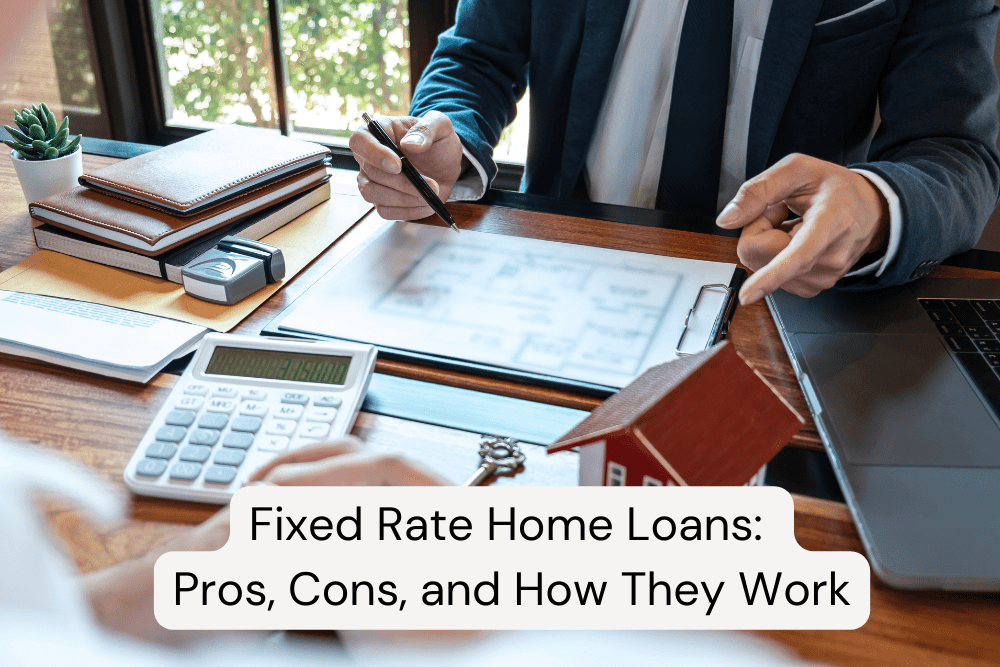In home financing, fixed rate home loans stand as a cornerstone for many aspiring homeowners. These loans come with a distinct feature that sets them apart from their counterparts – the stability of interest rates. A fixed rate home loan is a mortgage where the interest rate remains constant throughout the loan’s entire term, providing borrowers with a predictable and consistent monthly payment.
This steadfast nature of fixed rate home loans is achieved by setting the interest rate at the loan’s origination and maintaining it unchanged over the life of the mortgage. Borrowers can rest assured that, regardless of fluctuations in the broader economic landscape or the lending market, their interest rate will remain impervious to external forces.
- How Fixed Rate Home Loans Differ from Variable Rate Home Loans
- How Fixed Rate Home Loans Work
- Pros of Fixed Rate Home Loans
- Cons of Fixed Rate Home Loans
- Choosing the Right Fixed Rate Home Loan
- Understanding Loan Terms and Conditions
- Alternatives to Fixed Rate Home Loans
- How to Apply for a Fixed Rate Home Loan
- Conclusion
- Frequently Asked Questions (FAQs)
How Fixed Rate Home Loans Differ from Variable Rate Home Loans
While fixed rate home loans offer stability, variable-rate home loans, also known as adjustable-rate mortgages (ARMs), present a dynamic alternative. Unlike the steady nature of fixed rate loans, variable-rate mortgages feature fluctuating interest rates that may rise or fall over time, influenced by prevailing market conditions.
The fundamental distinction between these two loan types lies in the predictability they offer to borrowers. Fixed rate home loans guarantee a constant interest rate, allowing homeowners to plan their finances with certainty. On the other hand, variable-rate mortgages introduce an element of uncertainty, as the interest rate can adjust periodically, leading to potential fluctuations in monthly payments.
The allure of fixed rate home loans often lies in their appeal to risk-averse individuals seeking stability and protection against interest rate hikes. In contrast, variable-rate mortgages may be more attractive to those comfortable with potential fluctuations and who may benefit from lower initial interest rates.
How Fixed Rate Home Loans Work
A. Mechanics of Fixed Rate Loans
To grasp the inner workings of fixed rate home loans, it is crucial to delve into the mechanics behind these steadfast financial instruments. When a borrower secures a fixed rate mortgage, the lender agrees to lock in the interest rate at the time of loan origination. This interest rate remains constant throughout the agreed-upon loan term, which is typically 15, 20, or 30 years, offering a sense of stability and predictability to the borrower.
The monthly mortgage payment comprises two key components: the principal and the interest. The principal represents the original amount borrowed, while the interest denotes the cost of borrowing the money from the lender. Over time, as the borrower makes regular payments, a portion of each installment goes towards reducing the outstanding principal balance, and the remainder covers the interest accrued during that period.
B. Understanding Interest Rates and Repayment Structure
Interest rates for fixed rate home loans are typically determined based on prevailing market rates at the time of loan origination. The interest rate influences the total interest paid over the life of the loan, impacting the overall cost of homeownership. As the interest rate remains fixed, borrowers are shielded from the uncertainty of fluctuating rates, making budgeting and financial planning more straightforward.
The repayment structure of fixed rate home loans adheres to a well-defined schedule. Borrowers are obligated to make equal monthly payments over the loan term, with a considerable portion allocated towards interest during the initial years. As the loan matures, the balance shifts, and a higher proportion of each payment goes towards reducing the principal. This phenomenon, known as amortization, allows homeowners to gradually build equity in their property.
C. Loan Term Options for Fixed Rate Home Loans
Fixed rate home loans offer a range of loan term options to cater to diverse financial preferences and objectives. The most common loan terms are 15, 20, and 30 years. Opting for a shorter loan term, such as 15 years, generally results in higher monthly payments but allows borrowers to become mortgage-free more quickly, while also paying less interest over the life of the loan.
Conversely, selecting a longer loan term, like 30 years, leads to lower monthly payments, making homeownership more affordable. However, it also means a more extended commitment to the mortgage and paying more interest in the long run.
When choosing the appropriate loan term, borrowers should consider their financial capabilities, long-term goals, and overall financial strategy. While a shorter loan term may entail higher monthly payments, it can save money on interest and enable homeowners to build equity faster. A longer loan term may offer greater affordability but might incur more interest costs over time.
By comprehending the mechanics of fixed rate home loans, understanding how interest rates impact repayment, and exploring various loan term options, potential homeowners can make informed decisions about their mortgage, aligning their choice with their unique financial circumstances and aspirations.
Pros of Fixed Rate Home Loans
A. Stable Repayment Amounts
One of the most compelling advantages of fixed rate home loans is the stability they offer in repayment amounts. With a fixed interest rate, borrowers can breathe easy, knowing that their monthly mortgage payments will remain unchanged throughout the loan term. This predictability allows homeowners to plan their finances with confidence, avoiding the stress of potential fluctuations in payments that are common with variable-rate mortgages.
Stable repayment amounts provide a sense of security and financial assurance, enabling homeowners to allocate their resources efficiently and without sudden budgetary surprises. Whether during economic downturns or periods of inflation, fixed rate borrowers can rest assured that their mortgage payments will remain constant, allowing them to maintain stability in their financial lives.
B. Predictable Budgeting and Planning
The predictability of fixed rate home loans extends beyond stable repayment amounts. Homeowners can engage in comprehensive budgeting and long-term financial planning with greater ease. As fixed rate borrowers know precisely how much they need to allocate for their mortgage every month, they can align their overall budget with confidence.
By understanding their mortgage commitments, homeowners can better plan for other expenses, such as education, retirement savings, and investments. This predictability fosters financial discipline and empowers borrowers to make informed decisions about their financial future.
C. Protection Against Interest Rate Increases
In a dynamic economic environment, interest rates can be subject to fluctuations. However, fixed rate home loans provide a protective shield against interest rate increases. Once the loan agreement is established and the interest rate is locked in, borrowers are safeguarded from rising interest rates, regardless of changes in the broader market.
This advantage becomes particularly valuable during periods of rising interest rates, as fixed rate borrowers are shielded from potential hikes that could impact their monthly payments. The peace of mind that comes with this protection is especially appealing to risk-averse individuals who seek stability and financial security.
D. Easier to Understand and Manage
Compared to the intricacies of variable-rate mortgages, fixed rate home loans offer simplicity and ease of understanding. The straightforward nature of fixed rate loans makes them accessible to a wide range of borrowers, including first-time homebuyers who may be navigating the complexities of homeownership for the first time.
Additionally, managing fixed rate mortgages is generally less complex since borrowers do not need to monitor interest rate fluctuations or be concerned about the potential need for refinancing due to rate changes. The simplicity of fixed rate loans allows homeowners to focus on other aspects of their lives without being preoccupied by mortgage-related uncertainties.
Cons of Fixed Rate Home Loans
A. Higher Initial Interest Rates
While fixed rate home loans offer the advantage of interest rate stability, they often come with higher initial interest rates compared to their variable-rate counterparts. Lenders factor in the predictability they provide to borrowers and mitigate their own risk by setting slightly higher interest rates for fixed rate mortgages. This upfront cost can result in higher monthly payments during the initial years of the loan.
Although the initial rates may be higher, borrowers should consider the long-term benefits of stability and protection against future interest rate increases. Over time, the initial higher interest rate might prove to be a reasonable trade-off for the financial security that fixed rate loans offer.
B. Limited Benefit from Interest Rate Decreases
One of the drawbacks of fixed rate home loans is that borrowers may miss out on potential benefits when interest rates decrease in the market. Unlike variable-rate mortgages, which automatically adjust to reflect lower market rates, fixed rate borrowers are locked into their original interest rate for the entire loan term.
As a result, if interest rates significantly drop after a borrower secures a fixed rate mortgage, they might not fully benefit from the decreased rates unless they opt to refinance the loan. Refinancing, however, entails additional costs and considerations, making it a decision that requires careful evaluation.
C. Potential Break Costs for Early Repayment
Fixed rate home loans often come with strict terms and conditions, including penalties for early repayment. If a borrower decides to sell their property or refinance the loan before the fixed rate period ends, they may be subject to break costs or prepayment penalties.
These break costs are meant to compensate the lender for potential lost interest due to the early repayment. While such penalties are intended to protect the lender’s interests, they can be a significant financial burden for borrowers who need to sell or refinance for personal or financial reasons.
D. Less Flexibility in Loan Features
Compared to variable-rate mortgages, fixed rate home loans generally offer less flexibility in loan features. With variable-rate loans, borrowers may have access to features such as offset accounts, redraw facilities, or the ability to make extra repayments without incurring penalties.
On the other hand, fixed rate loans may limit or exclude some of these features, making it less convenient for borrowers who value the flexibility to manage their loan according to their changing financial circumstances.
Despite these drawbacks, fixed rate home loans remain a viable option for many homeowners seeking stability and consistency in their mortgage payments. Borrowers should carefully weigh the pros and cons and consider their financial goals and risk tolerance when making the decision between fixed rate and variable-rate mortgages. Understanding the potential drawbacks of fixed rate home loans allows borrowers to make informed choices that align with their long-term financial objectives.
Choosing the Right Fixed Rate Home Loan
A. Assessing Personal Financial Situation
When embarking on the journey of homeownership and selecting the right fixed rate home loan, the first crucial step is to assess one’s personal financial situation. Homebuyers must conduct an in-depth evaluation of their current financial standing, including income, expenses, debts, and credit score.
Understanding their financial capacity enables borrowers to determine how much they can afford to borrow and comfortably repay each month. This assessment helps set realistic expectations and ensures that borrowers select a fixed rate home loan that aligns with their financial capabilities, avoiding the risk of overextending themselves.
B. Comparing Fixed Rate Loans from Different Lenders
Once prospective homebuyers have a clear understanding of their financial situation, they should embark on comparing fixed rate home loan options from different lenders. It is essential to explore multiple lenders, such as banks, credit unions, and mortgage brokers, to find the best terms and conditions.
When comparing loans, borrowers should focus on key factors, including the interest rate, loan term, closing costs, and any additional fees or charges. Reading the fine print and understanding the loan’s terms will help borrowers identify the most suitable fixed rate home loan that meets their financial needs and aligns with their long-term goals.
C. Considering Loan Term and Features
The loan term is a critical aspect of selecting the right fixed rate home loan. Homebuyers should carefully weigh the advantages and disadvantages of various loan terms, such as 15, 20, or 30 years. Choosing the right loan term depends on factors like financial stability, future plans, and the desire to build equity faster or have lower monthly payments.
Additionally, potential borrowers should consider the features and flexibility offered by different fixed rate home loans. While fixed rate mortgages are generally more straightforward in structure, some lenders may offer additional features, such as offset accounts, redraw facilities, or the ability to make extra repayments. Evaluating these features is essential for borrowers who value flexibility and the ability to manage their loan effectively.
Furthermore, it is essential to inquire about any special loan programs or incentives available to certain types of borrowers, such as first-time homebuyers or veterans. Such programs might offer specific benefits or lower interest rates that can positively impact the overall affordability of the fixed rate home loan.
Understanding Loan Terms and Conditions
A. Loan Lock-in Periods
As borrowers delve into the process of securing a fixed rate home loan, they encounter an essential aspect known as the loan lock-in period. A lock-in period is a defined timeframe during which the interest rate and other terms of the loan are guaranteed to remain unchanged. This ensures that borrowers are protected from interest rate fluctuations while their loan application is processed and approved.
Lock-in periods typically vary among lenders and can range from a few weeks to several months. During this period, borrowers can secure a specific interest rate, providing peace of mind and allowing them to plan their finances accurately.
However, borrowers should be aware that while a lock-in period offers stability, it may also limit their ability to take advantage of potentially lower interest rates in the market during this period. If interest rates drop significantly after the lock-in period has expired, borrowers may need to reassess their options and consider potential refinancing or renegotiating the terms with the lender.
B. Additional Fees and Charges
Understanding the full spectrum of fees and charges associated with a fixed rate home loan is essential for borrowers to make informed financial decisions. While interest rates may be a significant consideration, borrowers should also pay attention to various additional fees that might be included in the loan agreement.
Common fees and charges might include origination fees, application fees, appraisal fees, processing fees, and legal fees. These costs can vary significantly among lenders and can impact the overall cost of obtaining the loan.
Prospective borrowers should carefully review the Loan Estimate provided by the lender, which provides a breakdown of the estimated costs associated with the loan. This allows borrowers to compare the total costs between different lenders and choose the option that best aligns with their budget and financial goals.
C. Early Repayment Options
The flexibility to make early repayments on a fixed rate home loan is an essential consideration for borrowers who anticipate the possibility of accelerated repayment or plan to settle the loan ahead of its scheduled term.
While fixed rate loans traditionally come with certain restrictions on early repayments to protect lenders from potential lost interest, some lenders may offer more generous options that allow borrowers to make extra repayments without penalties. These features are often referred to as offset accounts or redraw facilities.
Offset accounts enable borrowers to link a savings account to their mortgage, and the funds held in the account are offset against the outstanding principal, reducing the interest charged on the loan. Redraw facilities, on the other hand, allow borrowers to access any extra repayments they have made beyond the required minimum. Such flexibility can be valuable for borrowers seeking to reduce the overall interest paid over the life of the loan or create a financial safety net.
Alternatives to Fixed Rate Home Loans
A. Variable-Rate Home Loans
As an alternative to fixed rate home loans, variable-rate home loans, also known as adjustable-rate mortgages (ARMs), offer a different approach to interest rates and repayments. Unlike fixed rate loans, where the interest rate remains constant over the loan term, variable-rate mortgages feature interest rates that fluctuate periodically based on market conditions.
Variable-rate loans are often linked to a benchmark interest rate, such as the prime rate or the London Interbank Offered Rate (LIBOR), with an additional margin determined by the lender. The interest rate can adjust upward or downward during specific intervals, such as every month, quarter, or year, depending on the terms of the loan.
The appeal of variable-rate home loans lies in their potential to offer lower initial interest rates than fixed rate loans. This can be advantageous for borrowers who anticipate falling interest rates in the future. However, variable-rate loans introduce an element of uncertainty, as borrowers may face higher monthly payments if interest rates rise.
B. Split Home Loans
Split home loans provide a flexible compromise between fixed and variable interest rates. With a split home loan, borrowers divide their mortgage into two separate portions: one with a fixed interest rate and the other with a variable interest rate.
The fixed portion offers the stability of a fixed rate home loan, providing protection against interest rate increases for a specified period, typically between one to five years. This allows borrowers to enjoy consistent repayments during the fixed period.
Simultaneously, the variable portion of the loan exposes borrowers to fluctuations in interest rates. This portion is subject to market changes and will have repayments that vary accordingly.
By splitting their home loan, borrowers can hedge their bets, benefiting from the stability of fixed rates while having the opportunity to take advantage of potential interest rate decreases on the variable portion. Split home loans cater to borrowers who seek a balanced approach, combining elements of both fixed and variable-rate mortgages.
C. Introductory or Honeymoon Rate Loans
Introductory or honeymoon rate loans are a variant of variable-rate home loans that offer a low, discounted interest rate for an initial period. This introductory period, often ranging from six months to a year, aims to attract borrowers with enticingly low interest rates during the early stages of their loan.
After the honeymoon period ends, the interest rate on the loan typically reverts to the lender’s standard variable rate or another predetermined rate. Borrowers should be mindful of this change, as it could result in a significant increase in monthly payments once the discounted period concludes.
Introductory rate loans can be appealing for borrowers seeking lower initial repayments or those who expect to refinance or switch loans before the discounted period expires. However, borrowers must be prepared for potential adjustments to their repayments once the introductory period concludes.
How to Apply for a Fixed Rate Home Loan
A. Gathering Necessary Documents
Before embarking on the application process for a fixed rate home loan, prospective borrowers should gather essential documents to streamline the process and facilitate smooth communication with lenders. The specific requirements may vary slightly among lenders, but generally, the following documents are necessary:
- Proof of Identity: Valid government-issued identification, such as a passport or driver’s license.
- Proof of Income: Recent pay stubs, W-2 forms, or tax returns for self-employed individuals.
- Employment Verification: A letter from the employer confirming the borrower’s job position and salary details.
- Financial Statements: Bank statements, investment account statements, and other financial assets and liabilities documentation.
- Credit History: A credit report showing the borrower’s credit score and credit history.
- Proof of Assets: Documents related to any assets to be used for the down payment or closing costs, such as savings account statements or gift letters from relatives providing funds.
- Property Information: Details about the property being purchased, such as the purchase contract and property appraisal.
B. Pre-Approval and Loan Application Process
The first step in the application process for a fixed rate home loan is often obtaining pre-approval from a lender. Pre-approval involves the lender evaluating the borrower’s financial information and creditworthiness to determine the maximum loan amount they can qualify for. Pre-approval helps borrowers set a realistic budget for their home search and makes them more attractive to sellers as serious buyers.
Once pre-approved, borrowers can proceed with the formal loan application process. This involves submitting the gathered documents to the lender, who will assess the borrower’s financial health, creditworthiness, and ability to repay the loan. The lender will also consider the property’s value and condition, among other factors.
During the application process, borrowers should be prepared to answer any additional questions from the lender and provide any further documentation required for underwriting and loan approval.
C. Home Loan Application Timeline
The timeline for a fixed rate home loan application can vary depending on several factors, including the lender’s processes and the complexity of the borrower’s financial situation. On average, the home loan application process can take between 30 to 45 days from the time of application to loan approval.
The timeline is influenced by various steps, such as pre-approval, property appraisal, underwriting, and final loan approval. Delays may occur if additional documentation or information is needed or if there are any complexities related to the property’s title or appraisal.
To expedite the application process, borrowers can ensure that they provide all required documents promptly and respond to any requests from the lender in a timely manner. Additionally, staying organized and being proactive in seeking clarification or information from the lender can help keep the process on track.
Conclusion
In conclusion, fixed rate home loans stand as a cornerstone in the realm of homeownership, offering borrowers a stable and predictable path towards fulfilling their dreams of owning a home. Throughout this exploration, we have gained valuable insights into the world of fixed rate home loans, understanding their mechanics, benefits, drawbacks, and alternatives.
Fixed rate home loans provide borrowers with the reassurance of unchanging interest rates, ensuring stable repayment amounts over the loan term. This predictability empowers homeowners to budget and plan their finances with confidence, fostering financial security and discipline.
Remember, each borrower’s journey is unique, and finding the right fixed rate home loan is an individualized process. Armed with a thorough understanding of the intricacies of fixed rate mortgages, borrowers can confidently embark on this significant chapter of their lives, achieving their dream of owning a place to call home.
Frequently Asked Questions (FAQs)
Does Australia do fixed rate mortgages?
Yes, Australia offers fixed rate mortgages, allowing borrowers to secure a constant interest rate over the loan term for stability and predictable repayments.
How long is a fixed rate mortgage in Australia?
In Australia, fixed rate mortgages typically have terms of 1 to 5 years, with some lenders offering longer terms up to 10 years.
How do fixed rate mortgages work in Australia?
In Australia, fixed rate mortgages work by setting an agreed-upon interest rate at loan origination, which remains unchanged for the fixed term, ensuring consistent monthly repayments.
What Happens at the End of the Fixed Rate Period?
At the end of the fixed rate period in Australia, borrowers have options. They can negotiate a new fixed rate term, switch to a variable rate, or refinance with another lender.
Can I Switch to a Variable-Rate Loan Midway?
Yes, borrowers in Australia can switch to a variable-rate loan midway if they desire to take advantage of market-driven interest rates or if their financial circumstances change.
How Are Fixed Rate Loans Affected by Economic Conditions?
Economic conditions can impact fixed rate loans in Australia. If market interest rates rise, borrowers benefit from having a fixed rate. However, during periods of falling rates, they miss out on potential savings compared to variable-rate borrowers.






